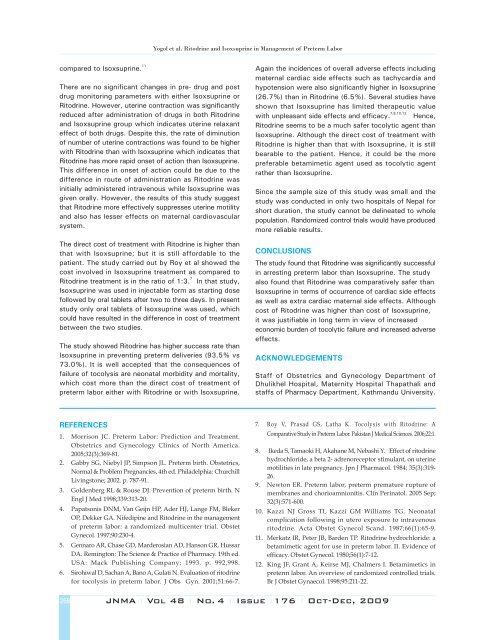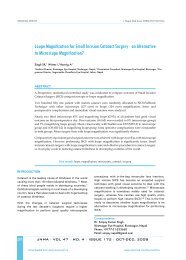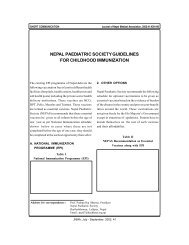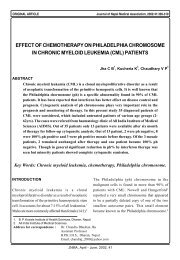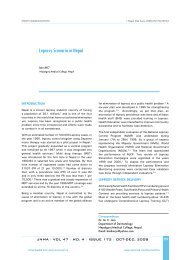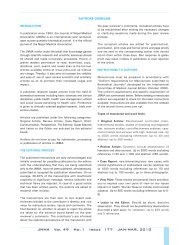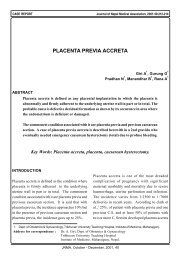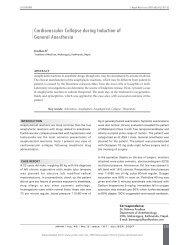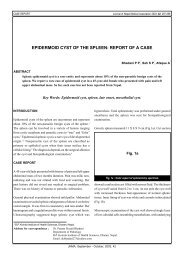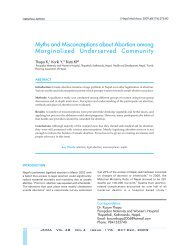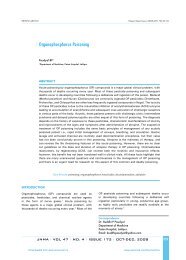Ritodrine and Isoxsuprine in Management of Preterm Labor
Ritodrine and Isoxsuprine in Management of Preterm Labor
Ritodrine and Isoxsuprine in Management of Preterm Labor
Create successful ePaper yourself
Turn your PDF publications into a flip-book with our unique Google optimized e-Paper software.
Yogol et al. <strong>Ritodr<strong>in</strong>e</strong> <strong>and</strong> <strong>Isoxsupr<strong>in</strong>e</strong> <strong>in</strong> <strong>Management</strong> <strong>of</strong> <strong>Preterm</strong> <strong>Labor</strong><br />
compared to <strong>Isoxsupr<strong>in</strong>e</strong>. 11<br />
There are no significant changes <strong>in</strong> pre- drug <strong>and</strong> post<br />
drug monitor<strong>in</strong>g parameters with either <strong>Isoxsupr<strong>in</strong>e</strong> or<br />
<strong>Ritodr<strong>in</strong>e</strong>. However, uter<strong>in</strong>e contraction was significantly<br />
reduced after adm<strong>in</strong>istration <strong>of</strong> drugs <strong>in</strong> both <strong>Ritodr<strong>in</strong>e</strong><br />
<strong>and</strong> <strong>Isoxsupr<strong>in</strong>e</strong> group which <strong>in</strong>dicates uter<strong>in</strong>e relaxant<br />
effect <strong>of</strong> both drugs. Despite this, the rate <strong>of</strong> dim<strong>in</strong>ution<br />
<strong>of</strong> number <strong>of</strong> uter<strong>in</strong>e contractions was found to be higher<br />
with <strong>Ritodr<strong>in</strong>e</strong> than with <strong>Isoxsupr<strong>in</strong>e</strong> which <strong>in</strong>dicates that<br />
<strong>Ritodr<strong>in</strong>e</strong> has more rapid onset <strong>of</strong> action than <strong>Isoxsupr<strong>in</strong>e</strong>.<br />
This difference <strong>in</strong> onset <strong>of</strong> action could be due to the<br />
difference <strong>in</strong> route <strong>of</strong> adm<strong>in</strong>istration as <strong>Ritodr<strong>in</strong>e</strong> was<br />
<strong>in</strong>itially adm<strong>in</strong>istered <strong>in</strong>travenous while <strong>Isoxsupr<strong>in</strong>e</strong> was<br />
given orally. However, the results <strong>of</strong> this study suggest<br />
that <strong>Ritodr<strong>in</strong>e</strong> more effectively suppresses uter<strong>in</strong>e motility<br />
<strong>and</strong> also has lesser effects on maternal cardiovascular<br />
system.<br />
The direct cost <strong>of</strong> treatment with <strong>Ritodr<strong>in</strong>e</strong> is higher than<br />
that with <strong>Isoxsupr<strong>in</strong>e</strong>; but it is still affordable to the<br />
patient. The study carried out by Roy et al showed the<br />
cost <strong>in</strong>volved <strong>in</strong> <strong>Isoxsupr<strong>in</strong>e</strong> treatment as compared to<br />
<strong>Ritodr<strong>in</strong>e</strong> treatment is <strong>in</strong> the ratio <strong>of</strong> 1:3. 7<br />
In that study,<br />
<strong>Isoxsupr<strong>in</strong>e</strong> was used <strong>in</strong> <strong>in</strong>jectable form as start<strong>in</strong>g dose<br />
followed by oral tablets after two to three days. In present<br />
study only oral tablets <strong>of</strong> <strong>Isoxsupr<strong>in</strong>e</strong> was used, which<br />
could have resulted <strong>in</strong> the difference <strong>in</strong> cost <strong>of</strong> treatment<br />
between the two studies.<br />
The study showed <strong>Ritodr<strong>in</strong>e</strong> has higher success rate than<br />
<strong>Isoxsupr<strong>in</strong>e</strong> <strong>in</strong> prevent<strong>in</strong>g preterm deliveries (93.5% vs<br />
73.0%). It is well accepted that the consequences <strong>of</strong><br />
failure <strong>of</strong> tocolysis are neonatal morbidity <strong>and</strong> mortality,<br />
which cost more than the direct cost <strong>of</strong> treatment <strong>of</strong><br />
preterm labor either with <strong>Ritodr<strong>in</strong>e</strong> or with <strong>Isoxsupr<strong>in</strong>e</strong>.<br />
Aga<strong>in</strong> the <strong>in</strong>cidences <strong>of</strong> overall adverse effects <strong>in</strong>clud<strong>in</strong>g<br />
maternal cardiac side effects such as tachycardia <strong>and</strong><br />
hypotension were also significantly higher <strong>in</strong> <strong>Isoxsupr<strong>in</strong>e</strong><br />
(26.7%) than <strong>in</strong> <strong>Ritodr<strong>in</strong>e</strong> (6.5%). Several studies have<br />
shown that <strong>Isoxsupr<strong>in</strong>e</strong> has limited therapeutic value<br />
with unpleasant side effects <strong>and</strong> efficacy. 7,8,10,12<br />
Hence,<br />
<strong>Ritodr<strong>in</strong>e</strong> seems to be a much safer tocolytic agent than<br />
<strong>Isoxsupr<strong>in</strong>e</strong>. Although the direct cost <strong>of</strong> treatment with<br />
<strong>Ritodr<strong>in</strong>e</strong> is higher than that with <strong>Isoxsupr<strong>in</strong>e</strong>, it is still<br />
bearable to the patient. Hence, it could be the more<br />
preferable betamimetic agent used as tocolytic agent<br />
rather than <strong>Isoxsupr<strong>in</strong>e</strong>.<br />
S<strong>in</strong>ce the sample size <strong>of</strong> this study was small <strong>and</strong> the<br />
study was conducted <strong>in</strong> only two hospitals <strong>of</strong> Nepal for<br />
short duration, the study cannot be del<strong>in</strong>eated to whole<br />
population. R<strong>and</strong>omized control trials would have produced<br />
more reliable results.<br />
CONCLUSIONS<br />
The study found that <strong>Ritodr<strong>in</strong>e</strong> was significantly successful<br />
<strong>in</strong> arrest<strong>in</strong>g preterm labor than <strong>Isoxsupr<strong>in</strong>e</strong>. The study<br />
also found that <strong>Ritodr<strong>in</strong>e</strong> was comparatively safer than<br />
<strong>Isoxsupr<strong>in</strong>e</strong> <strong>in</strong> terms <strong>of</strong> occurrence <strong>of</strong> cardiac side effects<br />
as well as extra cardiac maternal side effects. Although<br />
cost <strong>of</strong> <strong>Ritodr<strong>in</strong>e</strong> was higher than cost <strong>of</strong> <strong>Isoxsupr<strong>in</strong>e</strong>,<br />
it was justifiable <strong>in</strong> long term <strong>in</strong> view <strong>of</strong> <strong>in</strong>creased<br />
economic burden <strong>of</strong> tocolytic failure <strong>and</strong> <strong>in</strong>creased adverse<br />
effects.<br />
ACKNOWLEDGEMENTS<br />
Staff <strong>of</strong> Obstetrics <strong>and</strong> Gynecology Department <strong>of</strong><br />
Dhulikhel Hospital, Maternity Hospital Thapathali <strong>and</strong><br />
staffs <strong>of</strong> Pharmacy Department, Kathm<strong>and</strong>u University.<br />
REFERENCES<br />
1. Morrison JC. <strong>Preterm</strong> <strong>Labor</strong>: Prediction <strong>and</strong> Treatment.<br />
Obstetrics <strong>and</strong> Gynecology Cl<strong>in</strong>ics <strong>of</strong> North America.<br />
2005;32(3):369-81.<br />
2. Gabby SG, Niebyl JP, Simpson JL. <strong>Preterm</strong> birth. Obstetrics,<br />
Normal & Problem Pregnancies, 4th ed. Philadelphia: Churchill<br />
Liv<strong>in</strong>gstone; 2002. p. 787-91.<br />
3. Goldenberg RL & Rouse DJ. Prevention <strong>of</strong> preterm birth. N<br />
Engl J Med 1998;339:313-20.<br />
4. Papatsonis DNM, Van Geijn HP, Ader HJ, Lange FM, Bleker<br />
OP, Dekker GA. Nifedip<strong>in</strong>e <strong>and</strong> <strong>Ritodr<strong>in</strong>e</strong> <strong>in</strong> the management<br />
<strong>of</strong> preterm labor: a r<strong>and</strong>omized multicenter trial. Obstet<br />
Gynecol. 1997;90:230-4.<br />
5. Gennaro AR, Chase GD, Marderosian AD, Hanson GR, Hussar<br />
DA. Rem<strong>in</strong>gton: The Science & Practice <strong>of</strong> Pharmacy. 19th ed.<br />
USA: Mack Publish<strong>in</strong>g Company; 1993. p. 992,998.<br />
6. Sirohiwal D, Sachan A, Bano A, Gulati N. Evaluation <strong>of</strong> ritodr<strong>in</strong>e<br />
for tocolysis <strong>in</strong> preterm labor. J Obs Gyn. 2001;51:66-7.<br />
7. Roy V, Prasad GS, Latha K. Tocolysis with <strong>Ritodr<strong>in</strong>e</strong>: A<br />
Comparative Study <strong>in</strong> <strong>Preterm</strong> <strong>Labor</strong>. Pakistan J Medical Sciences. 2006;22:1.<br />
8. Ikeda S, Tamaoki H, Akahane M, Nebashi Y. Effect <strong>of</strong> ritodr<strong>in</strong>e<br />
hydrochloride, a beta 2- adrenoreceptor stimulant, on uter<strong>in</strong>e<br />
motilities <strong>in</strong> late pregnancy. Jpn J Pharmacol. 1984; 35(3):319-<br />
26.<br />
9. Newton ER. <strong>Preterm</strong> labor, preterm premature rupture <strong>of</strong><br />
membranes <strong>and</strong> chorioamnionitis. Cl<strong>in</strong> Per<strong>in</strong>atol. 2005 Sep;<br />
32(3):571-600.<br />
10. Kazzi NJ Gross TL Kazzi GM Williams TG. Neonatal<br />
complication follow<strong>in</strong>g <strong>in</strong> utero exposure to <strong>in</strong>travenous<br />
ritodr<strong>in</strong>e. Acta Obstet Gynecol Sc<strong>and</strong>. 1987;66(1):65-9.<br />
11. Merkatz IR, Peter JB, Barden TP. <strong>Ritodr<strong>in</strong>e</strong> hydrochloride: a<br />
betamimetic agent for use <strong>in</strong> preterm labor. II. Evidence <strong>of</strong><br />
efficacy. Obstet Gynecol. 1980;56(1):7-12.<br />
12. K<strong>in</strong>g JF, Grant A, Keirse MJ, Chalmers I. Betamimetics <strong>in</strong><br />
preterm labor. An overview <strong>of</strong> r<strong>and</strong>omized controlled trials.<br />
Br J Obstet Gynaecol. 1998;95:211-22.<br />
268<br />
JNMA I Vol 48 I No. 4 I Issue I176 I Oct-Dec, 2009


